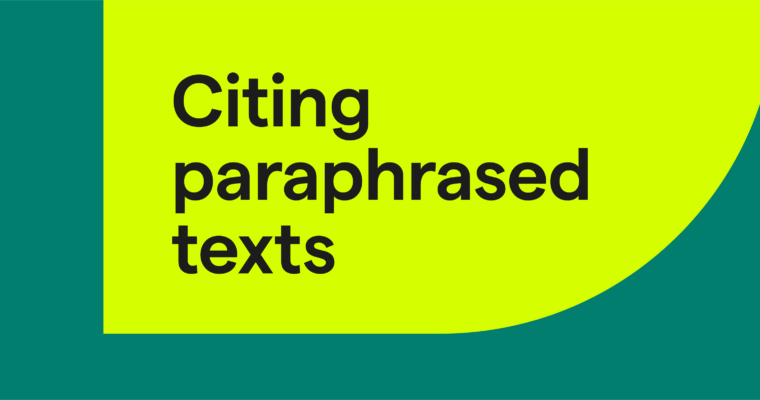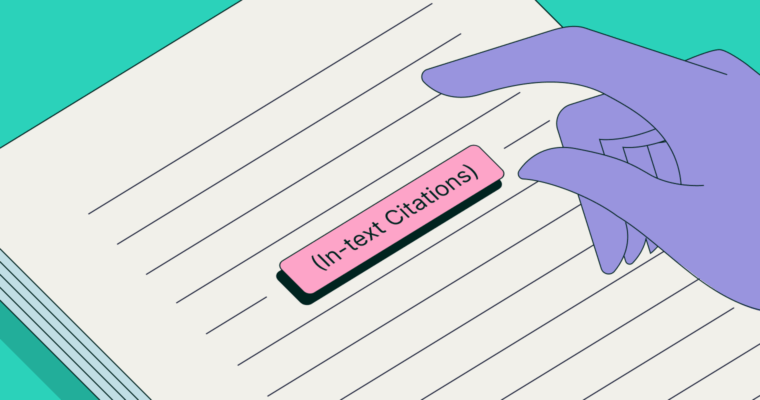
Paraphrasing might seem like a way of avoiding plagiarism, but it can be considered a form of plagiarism if you don’t cite the original source. Citing paraphrases involves more than just mentioning the author’s name. Each formatting style—APA, MLA, or Chicago—has its own particular rules about how to cite paraphrased information, and these contrasting styles can be confusing.
Below, we review the rules for citing paraphrases in MLA, APA, and Chicago formats. We’ll break down the guidelines and share a paraphrase citation example or two for each style so you can see how to do it yourself.
How to cite a paraphrase
Paraphrasing is when you restate someone else’s text or speech in your own words, keeping the original meaning. There are two challenges to doing this. One, which we’ll come back to in a minute, is that you have to cite a source, even though you’re not quoting it directly. The other challenge is that it’s not always easy to find a new way of saying what your source already said. Need help with that? In addition to the techniques mentioned in our paraphrasing guide, you can also check out our free paraphrasing tool, which lets you paste in up to 500 characters of text and then suggests a few different paraphrases for you to choose from. Navigate responsible AI use with Grammarly’s AI checker, trained to identify AI-generated text.
One important point. You don’t need quotation marks if you are paraphrasing. Quotation marks are only for direct quotes, where you copy the original source’s wording exactly.
Now, back to the other challenge we mentioned. When you paraphrase, in order to avoid plagiarism, you need to include a citation. Citing a paraphrase in writing usually involves adding the author’s name and other information in parentheses next to the passage. This is called an in-text citation or parenthetical citation. Sometimes footnote or endnote citations can be used instead.
In academic writing, the formatting of an in-text citation and the information to include depend on the style you’re following: APA, MLA, or Chicago. Each style has its own unique rules, though there are some similarities between them. Below, we discuss the rules of citing paraphrases, based on which style you’re using.
Here’s another essential point. Along with creating an in-text citation or a footnote or endnote citation, you also need to add a full citation for the source in the bibliography at the end of your writing. Full citations usually include details about the publication, such as the publishing company or internet URL. Which details to include and in what order again depends on the formatting style. You can read all about that in our APA, MLA, and Chicago guides linked above. And you can use our free citation generator to help you along.
Citing paraphrases: APA
The APA format uses an author-date system for citing a paraphrased passage. This involves placing the author’s surname (last name) and the year of publication in parentheses, separated by a comma. An APA-style in-text citation for a work with two authors would look like this:
(Bell & Offen, 1983)
The in-text citation should occur at the end of the passage, but before the concluding punctuation: at the end of a sentence before the period, or at the end of a clause before the semicolon or comma.
If you mention either the author’s name or the year of publication in the words of your own text, known as a narrative citation, you can omit that information from the APA paraphrasing citation. In narrative citations that mention only the author, put the year in parentheses after the author’s name instead of the end of the passage. This may sound complicated, but it’ll be more clear if you look at some examples.
APA paraphrasing citation example
Researchers recently discovered that Kundalini yoga improved cognition and memory in several older women at risk for Alzheimer’s disease (Lavretsky, 2024).
In a 2024 study, researchers discovered that Kundalini yoga improved cognition and memory in several older women at risk for Alzheimer’s disease (Lavretsky).
The research team of Dr. Helen Lavretsky (2024) recently discovered that Kundalini yoga improved cognition and memory in several older women at risk for Alzheimer’s disease.
In a 2024 study, the research team of Dr. Helen Lavretsky discovered that Kundalini yoga improved cognition and memory in several older women at risk for Alzheimer’s disease.
Citing paraphrases: MLA
Paraphrase citing in MLA uses the author’s surname in parentheses, but with the page numbers instead of the year of publication. There is no comma to separate them, so numbers in MLA in-text citations generally refer to a page.
If you mention either the author or the page in the text—a narrative citation—you can omit that information from the citation. This is more common with the author than the page number, so in MLA papers you will often see only the page number in parentheses.
MLA paraphrasing citation example
Someone whose words and actions are not genuine, but instead represent those of another person, is considered to be an “artificial person” (Hobbes 113).
Someone whose words and actions are not genuine, but instead represent those of another person, is considered to be what Hobbes calls an “artificial person” (113).
Citing paraphrases: Chicago
The Chicago style provides for two different systems of citing sources. We’ll briefly describe each, but you don’t necessarily get to take your pick. If you’re writing for school, you’ll probably be told which system to apply. One is called the author-date system; it’s commonly used in the sciences. The other, known as the notes-and-bibliography system, is more often used in the humanities. Bear with us—this can be complicated!
The author-date system calls for using brief, in-text citations and giving full details in a reference list. The in-text citation is like APA but slightly different. You give the author’s last name followed by a space (but no comma) and the year of publication; then you add a comma and the page number if one is needed.
In the notes-and-bibliography system, you simply put a superscript number in your text (after the punctuation ending your paraphrase), and you provide the relevant citation information in a footnote or endnote. Footnotes go at the bottom of the page; endnotes go in a separate section after the main body of your text. Under this system, you can either:
- Give all the needed details in the notes (a full citation the first time you reference that source, but a short form for later references) and omit a bibliography, or
- Give concise information in the notes (the author’s surname, an abbreviated title of the source, and the relevant page numbers) and give a full citation in a bibliography.
Chicago paraphrasing citations example
The first ruler to create a navy as we know it today was Minos of Crete, who used his to control what he called the Hellenic Sea, today known as the Aegean Sea (Thucydides 1972, 37).
The first ruler to create a navy as we know it today was Minos of Crete, who used his to control what he called the Hellenic Sea, now known as the Aegean Sea.1
1. Thucydides, The History of the Peloponnesian War, 37.
How to Cite a Paraphrased Text FAQs
Do I have to cite a source if I paraphrase and don’t directly quote?
Yes, in formal writing like research papers you still need to cite a source after you paraphrase its message. You need to include both an in-text citation, such as a parenthetical citation, as well as a full citation in the bibliography at the end of your work.
What are the differences in citing a paraphrase between MLA, APA, and Chicago styles?
MLA, APA, and Chicago styles can all use in-text citations, also known as parenthetical citations. For APA and Chicago, this includes the author’s last name and the year of publication, whereas in MLA it includes the author’s last name and page number. Chicago also has the option of using footnotes or endnotes instead of a parenthetical citation.
Where does the citation go when citing a paraphrase?
In-text or parenthetical citations appear at the end of the passage before the concluding punctuation. For example, you could put them at the end of a sentence before the period or at the end of a clause before the semicolon or comma. For footnotes and endnotes, the superscript number appears at the end of the passage after the punctuation.





